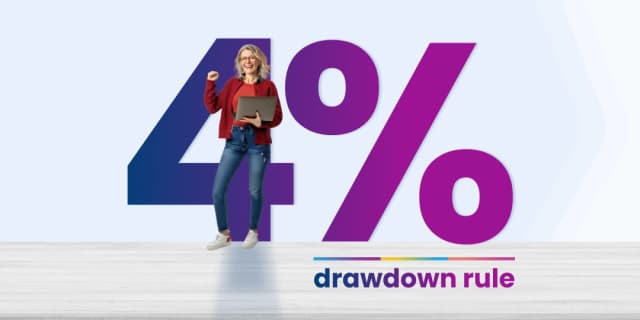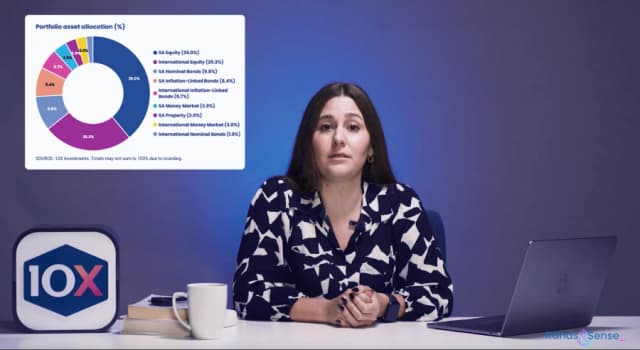Decoding drawdown rates: How much can you safely withdraw from your Living Annuity ?
10 December 2024

Moving jobs? How to grow your pension and protect your retirement through career change
A living annuity is a retirement savings investment product that allows you to draw a consistent income during retirement while preserving your purchasing power and potentially growing your invested savings. With a living annuity, you can manage your investment portfolio with flexibility, adjust your withdrawals as needed, and leave your capital to nominated beneficiaries when you pass away (and the living annuity doesn’t form part of your estate, either, which makes it a good option for avoiding estate duties). For answers to all the most popular questions we get on living annuities, see our Living Annuity FAQ page.
With increased financial control, you can grow your savings by adjusting the underlying asset mix of your portfolio and change your drawdowns to suit your current position (potentially even reinvesting any excess), instead of earning a fixed income for life and losing your capital in the end with a life (guaranteed) annuity. Properly managed, a living annuity can enable you to live off the returns it generates, and can therefore be beneficial for prolonging the life of your retirement savings.
The ability to adjust income withdrawals gives you the freedom to adapt your retirement income according to market conditions and your own financial needs. However, while a living annuity grants retirees more control over their finances, the rate at which funds are drawn (known as your drawdown rate) can have a significant impact on the long-term sustainability of your retirement income. To make sure that you don’t outlive your savings, it is crucial to consider and understand the optimal way to structure your drawdown rate in order to balance it with your other costs and the return on your investment.
Applying The Golden Equation To Retirement Income
The ‘Golden Equation’ is a formula you can apply to your retirement income that takes into account drawdown rates, fees and inflation. The essence of the golden equation is simple: your total expenses (the sum total of drawdowns, fees, and inflation) must not exceed your investment returns. Balancing these factors is crucial to ensure your savings last throughout your retirement years.
Drawdowns + Fees + Inflation ≤ Return on Investment
Here’s a quick breakdown of each factor:
Inflation: As inflation increases the price of goods and services, it also decreases the purchasing power of your money. Over time, fixed income amounts will continue to buy less, which means investments that don’t return more than inflation are effectively making you poorer. To generate ‘real’ returns, investments need to grow at a rate that exceeds inflation.
Drawdown Rate: A sustainable drawdown rate will differ between investors based on their income requirements, their capital amount and the fees they are paying (inflation being a cost that is similar for all), but it is defined as a percentage of the capital amount that when added to inflation and fees does not lead to capital depletion. In fact, a sustainable drawdown rate could even allow for growth.
Fees: Fees play a crucial role in shaping the growth (or depletion) of your investment. When fees are low, they support long-term growth, but high fees can gradually eat away at returns, reducing the overall value of your savings. Over time, high fees compound, diminishing returns and eroding capital. In contrast, lower fees allow more of your returns to be reinvested, letting compounding work in your favour.

Let’s look at a practical hypothetical example of the interplay between these factors. If your living annuity investment returned 12% annually, and inflation was constant at 6%, that leaves you the other 6% with which to account for fees and drawdowns. Research suggests a sustainable drawdown rate is around 4%, which means that if your fees are low, say 1% or less, you still have 1% of your return to reinvest in your living annuity, which could lead to growth of the capital amount over time. If you are paying fees of 2.8% or more (as is relatively common in the industry), you only have 3.2% to drawdown before your capital starts to get depleted. All thoughts of growth in the investment are rendered moot. If you think you’re paying too much for underperforming investments, you can get a free comparison report from 10X. Our low fees and superior returns could help you achieve the retirement you deserve.
The key to enhancing the stability and longevity of your retirement income lies in balancing these three factors. With a sustainable drawdown rate, inflation-beating asset allocation and consistently low fees, you can maintain the sustainability of your savings and outpace inflation. By diversifying investment strategies and offering efficient fee structures, 10X Investments makes this possible.
The Drawdown Deal-Breaker: Living Annuities vs Life (Guaranteed) Annuities
Outpacing inflation by a healthy margin has a potentially significant impact on investment value, which is why many investors prefer living annuities over life (guaranteed) annuities. Additionally, a living annuity grants investors more freedom in both their income options and investment decisions.
Regardless of market performance, life (guaranteed) annuities provide consistent payments, but unless the annuity is inflation-linked (which might also mean a smaller initial amount of income) the value of these payments will diminish over time as inflation corrodes purchasing power. Even if the annuity is designed to increase annually in line with inflation, rising prices in other areas can still outpace these adjustments, leaving retirees with reduced purchasing power over all. As economic conditions are consistently changing, the inflexible nature of life (guaranteed) annuities (along with the fact that your capital is claimed by the insurer, not your beneficiaries, on your death) can be a turn-off for savvy investors.

A living annuity, however, offers a more flexible solution for retirees. You can adjust income withdrawals to keep pace with changing inflation rates. Similarly, you can raise or lower your drawdown rate according to your expenses, allowing you to access the amount of income you need to fund your lifestyle. You can also keep drawdowns low if you have other sources of income, which gives you a very good chance at investment growth. As a living annuity investor, you get to decide whether you’d like to receive your income monthly, quarterly, semi-annually or annually. If you’d like to change these adjustments, you can alter them annually before the anniversary date of your policy.
Striking a balance between rising inflation rates, your income drawdown, and the fees you pay on your investment is essential for protecting your capital over the long term and ensuring that you don’t run out of money in retirement. By using the golden equation to ensure that these three cost together do not exceed the returns generated by your investment, your funds will be preserved and carry you throughout your retirement years.
Optimal Drawdown Rates For Long-Term Stability
In South Africa, the legal drawdown range is mandated at between 2.5% and 17.5%. Within this range, you have the flexibility to adjust your drawdown according to your changing financial needs throughout retirement. To ensure long-term income stability, however, it’s often best to stick to a conservative drawdown rate as this decreases the risk of funds running out prematurely. Research suggests a sustainable drawdown range is between 4-5% of your annuity value.
At 10X Investments, we offer portfolio management resources and retirement planning tools, as well as highly-experienced investment consultants (at no cost to you) so that you can effectively balance the demands on your investment returns in a way that suits you, your income needs, and your financial future. With our living annuity calculator, you can estimate how much monthly income you could receive with your current retirement savings.
Diversified Asset Allocation For Sustainable Income And Growth Potential
With 10X, you have the freedom to change your underlying investment portfolio to suit your preferences, and we offer a range of funds with varying asset allocations to accommodate different levels of risk tolerance, time horizons, and investment goals.
If you’re a more conservative investor, you may prefer a larger portion of your investment in defensive assets like bonds. If you have a higher risk tolerance, however, you may choose to allocate more investment towards equities. Overall, ensuring you have the right mix to weather market variability while also preserving capital and even giving you a shot at growth is the most important thing. Remember the old chestnut “Don’t put all your eggs in one basket”? The technical term is diversification, and it’s a cornerstone of the 10X investment philosophy.
Another strategic win for 10X investors is our use of index tracking. Index trackers mirror the performance of an index (a group of assets such as the stocks that make up the S&P 500), rather than actively picking stocks based on individual performance on an ongoing basis. Not only do index funds tend to outperform their active counterparts over time, but they generally have fewer research, management and trading overheads, making them a more cost-effective option.
Aside from the benefits of a well-diversified and low-cost fund, the 10X living annuity offers up to 100% offshore investment, which allows investors to combat country-specific risks as well as protect against a potential depreciation of the Rand.
While safeguarding your investments early on can be beneficial, many retirees end up being too conservative too early with their money. When purchasing a living annuity, investors often underestimate the length of time for which they are going to be retired. In today’s world, it’s not uncommon to be retired for 20 years, or even 30. So it’s incredibly important that investors consider the time horizon of their annuity before making investment decisions. The ideal approach is to find the right balance in your portfolio based on your financial needs, time horizon, and risk tolerance, and to understand that it might well be the case that your investment does not start producing growth-enabling returns for a few years. Which is why it is always good to be able to rely on other income streams, most especially in the first few years of retirement.
With a strategically planned asset mix, regularly adjusted, and low fees, not only will you be able to maintain purchasing power and protect against inflation, you’ll also be able to offer yourself the best chance of sustainable investment growth and securing a stable retirement income that lasts throughout your golden years.
Offshore Investing
A quick further note on offshore investing: before looking at the ideal mix of local and offshore investment, it is important to have a good view of how assets and liabilities stack up. If the majority of your costs are Rand-based, it might not make sense to have a lot of money in Dollar-based assets. To learn more about the risks and rewards of offshore investing, take a look at this blog.
Discussing Drawdowns: Tailoring Your Living Annuity Withdrawals
How Much Can I Withdraw From My Living Annuity?
As mentioned, the legally mandated drawdown rate in South Africa is between 2.5% and 17.5%. As an investor, you want to ensure that your funds will last by sustaining as low a drawdown rate as possible - this increases the potential longevity of your retirement savings. You’re more likely to deplete your capital faster should you have a higher drawdown rate. To ensure the sustainability of your annuity, a drawdown rate of between 4-5% is recommended as exceeding this limit could put financial strain on your funds over time.
What Can I Do With Excess Funds?
A minimum drawdown of 2.5% can sometimes generate more income than needed. Should you be in the possession of surplus funds, one option is to reinvest those funds into a retirement annuity. You then get the tax benefits associated with the RA, and those funds can later be retired into a living annuity.
Do I Have To Purchase A Living Annuity?
Legally, a minimum of two-thirds of your retirement savings must be used to purchase either a living annuity or a life (guaranteed) annuity when you retire (the minimum age for which is 55). The remainder of your savings, of which a R550k portion is tax-free, will then be available as a cash lump sum should you choose to take it as such. Using this tax-free amount can not only help you to meet your financial needs in the short-term, but can potentially also help you lower the drawdown rate of your living annuity during the early stages of retirement.
How Can I Lower My Drawdown Rate?
Having the above-mentioned tax-free lump sum available can be a financial buffer for retirees and can potentially help grow a living annuity investment by limiting the need for excessive withdrawals early on. Two other ways to lower your drawdown rate are to minimise your living costs and to make sure you have other income streams available. The first five to ten years of retirement present a great chance to further leverage the compound interest of the retirement savings in your living annuity, so limiting drawdowns and costs associated with living expenses and fees is a good idea.
As an investor, you want to ensure that your savings last throughout your lifetime by managing your drawdown rate wisely, especially since life expectancy is on the rise. To protect your living annuity and ensure financial stability for the future, it is essential that you plan for the long-term, maintain a sustainable drawdown and get the most out of any tax benefits.
At 10X, we’ve been helping South African retirees make great investment decisions for over a decade. If you think your investments could be doing more for you, get in touch.
Related articles
How can we 10X Your Future?
Begin your journey to a secure future with 10X Investments. Explore our range of retirement products designed to help you grow your wealth and achieve financial success.





